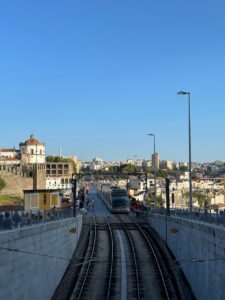How to Navigate Transportation In Porto, Portugal
Portugal is a country with a robust public transportation system within its main cities like Porto and Lisbon. And train travel is possible to just about anywhere in the country. However, it is not always the most efficient way to get around.
We first arrived in Portugal at the airport in Porto. From the airport, our hotel was located in the heart of the Bolhao area of the city, which is also close to the Trindade metro station. The Trindade station is the main hub for the metro lines in Porto. From this station, you can take any of the other metro lines that Porto has, most of which cross along the northern part of the city center from east to west including to the airport.
Figuring out which metro line to take from the airport was the easy part, as they all went to Trindade station. The difficult part for us was purchasing the tickets to get on the metro line. Being a tourist there are some different options to purchase public transportation. The first is the Porto card which must be purchased at one of the tourism offices. This is your most expensive option up front but does provide free entry to some museums and discounts at others. So if you plan to do lots of sightseeing in Porto this might be the best option.
the airport was the easy part, as they all went to Trindade station. The difficult part for us was purchasing the tickets to get on the metro line. Being a tourist there are some different options to purchase public transportation. The first is the Porto card which must be purchased at one of the tourism offices. This is your most expensive option up front but does provide free entry to some museums and discounts at others. So if you plan to do lots of sightseeing in Porto this might be the best option.
The next option is the Andante tour card. This card gives you access to unlimited rides on the public buses and metro for 1 or 3 days. This card cannot be reloaded for additional rides and can only be purchased at the Andante shops. It cannot be purchased at the self-serve kiosks and is different than the 24-hour card from those self-serve kiosks. If you plan to travel within many of the different zones within Porto or don’t want to worry about the zone you are traveling in, this is the right card for you.
Finally there are the Andante cards you can purchase from the self serve kiosks that are at the metro lines. This is what we ended up doing because we were sure how many days we were going to need the cards plus there was no one at any of the shops at the airport for us to purchase the other cards. Using the self serve kiosk can be a bit of a frustrating process. At the airport and at the Trindade station there are always long lines to purchase tickets. Additionally the verbiage used to purchase tickets is confusing. For example, if you select 2 tickets for 24 hours, it isn’t purchasing two separate tickets for 24 hours. You’re really purchasing a 48 hour ticket for one person. The other inefficient aspect of the self serve kiosks is that you can only purchase one person’s ticket per transaction. So if you have four people in your group you are purchasing tickets for, you have to make four separate transactions. On top of that, the credit card readers don’t work very well so it can take several tries to run your credit card before the transaction actually goes through. So for four people, you’re trying multiple times to run your credit card for each person’s ticket. After going through all of this we realized why the ticket lines were so long.
There isn’t any security or gates or anything to get onto the metro lines in Porto. You could just hop on if you really wanted to, but if you get caught without a ticket you will get fined or even worse, so I wouldn’t recommend it. There are little boxes throughout the metro stations that you tap your ticket against. We found that sometimes these were hard to find as they weren’t always right at the entrances. And you are supposed to scan your tickets each time you change trains as well if you need to. Again the boxes are not right near the transfer areas and there arent any signs as to which box you are supposed to scan your tickets at. This is why we were happy to just get a 24 hour pass, then we didn’t have to worry about how many times we scanned our cards.
The ticketing part of the metro line is the most difficult piece to maneuver. Once you are on the metro line things are pretty smooth. Most of the metro lines in Porto move along the northern part of the city, and there is only one line (the D line) that goes across the Duoro River to Vila Nova de Gaia. This ended up being the line that we took the most from our hotel as it got us to the historic city center and Sao Bento station and across the river to the wine cellars.
 Since we were with our two kids we did take a stroller with us, which for the most part was easy to get on and off the metro line. And the people in Porto were very accommodating in letting our older daughter have a seat when the trains were busy. And there were times when they got very crowded.
Since we were with our two kids we did take a stroller with us, which for the most part was easy to get on and off the metro line. And the people in Porto were very accommodating in letting our older daughter have a seat when the trains were busy. And there were times when they got very crowded.
The Andante card not only gets you access to the metro lines but also all of the bus routes within the city. If you want to go the Foz area of the city or explore further into Vila Nova de Gaia, you’ll need to take the bus to get there, as the metro lines do not go to this part of the city. The buses are pretty easy to navigate as well. There are routes that will take you from the city center out to the Foz area and the coastline, which I highly recommend taking some time to see. The buses, however, do not run down along the river on the Vila Nova side, so if you want to get down to the river you will either have to walk or take the cable car, which I will talk more in a little bit.
We found that the buses generally ran on time. They did get full during peak times, like as soon as it got dark going into the city from the coastline. This caused the bus to not be able to accept people at certain stops because it was full. So plan your trip accordingly.
While you can’t take a bus to get near the river by the wine cellars on the Vila Nova side, you do have another option; the Teleferico de Gaia. This cable car will take
you from the Jardim do Morro metro line at the top of the riverbank, down to the bottom. The cable car runs along the river so you get some very nice views. The ride is only about 5 minutes long and costs 7 Euros one way or 10 Euros for a round-trip ticket. However, if it is a warm day out and you don’t want to walk up the hills, it is certainly worth it to at least take the cable car one way up. We did this several times. Especially with kids, after a day of sightseeing, walking uphill was not going to happen with them.
ride is only about 5 minutes long and costs 7 Euros one way or 10 Euros for a round-trip ticket. However, if it is a warm day out and you don’t want to walk up the hills, it is certainly worth it to at least take the cable car one way up. We did this several times. Especially with kids, after a day of sightseeing, walking uphill was not going to happen with them.
Another option to get up the hill from the Duoro River is to take the funicular. The funicular is on the Porto side of the Duoro River. It costs 4 Euros for a one-way ticket and you have to pay in exact cash only. We didn’t end up taking this at any point in time since the cable car was just an easier option.
We did a lot of walking while we were exploring Porto as the city is fairly compact. Had we been without kids, it likely would have been even more walking. Like most European cities the streets are not always laid out so straightforward. Especially with the hills of the city, sometimes a street that looks near isn’t as close as you think. But if you have a good map application on your phone that lets you know if there are hills or stairs, you should have no problem getting around.
The ease of getting around Porto, whether it be by metro line, by bus or by foot, is another reason why Porto should be on your bucket list.

